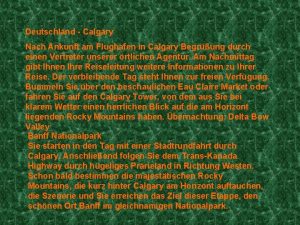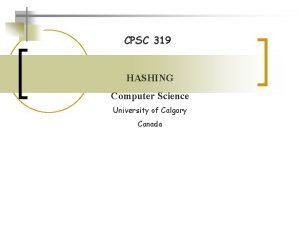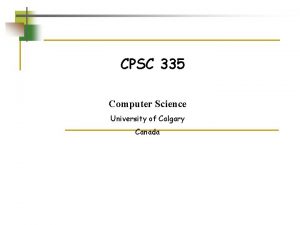University of Calgary CPSC 441 HTTP Servers and
















- Slides: 16

University of Calgary – CPSC 441 HTTP Servers and Proxies Parts of these slides are courtesy of Erich Nahum (IBM Research)

Introduction to HTTP Laptop w/ Netscape � http request http response Server w/ Apache HTTP: Hyper. Text Transfer Protocol Communication protocol between clients and servers Application layer protocol for WWW � Client/Server model: Client: browser that requests, receives, displays object Server: receives requests and responds to them � Protocol consists of various operations Few for HTTP 1. 0 (RFC 1945, 1996) Many more in HTTP 1. 1 (RFC 2616, 1999) Desktop w/ Explorer

HTTP Request Generation � User clicks on something � Uniform Resource Locator (URL): scheme: //domain: portnumber/the path of the resource http: //www. cnn. com http: //www. cpsc. ucalgary. ca: 80/~carey https: //www. paymybills. com ftp: //ftp. kernel. org Different URL schemes map to different services � Hostname is converted from a name to a 32 -bit IP address (DNS lookup) � Connection is established to server (TCP)

What Happens Next? � Client downloads HTML page Typically in text format (ASCII) Contains instructions for rendering (e. g. , background color, frames) � Many have embedded objects Images: GIF, JPG (logos, banner ads) Usually automatically retrieved ▪ I. e. , without user involvement ▪ User may be able to change setting for automatic retrievals <html> <head> <meta name=“Author” content=“Erich Nahum”> <title> Sample HTML Page </title> </head> <body text=“#00000”> <img width=31 height=11 src=“ibmlogo. gif”> <img src=“images/new. gif> <h 1>Hi There!</h 1> Here’s lots of cool linux stuff! <a href=“more. html”> Click here</a> for more! </body> </html>

Web Server Role � Respond to client requests, typically a browser Can be a proxy, which forwards user requests Could be search engine spider or robot (e. g. , google) � May have work to do on client’s behalf: Is the client’s cached copy still good? Is client authorized to get this document? � Hundreds or thousands of simultaneous clients Hard to predict how many will show up on some day (e. g. , “flash crowds”, diurnal cycle, global presence) Many requests are in progress concurrently

HTTP Request Types Called Methods: � GET: retrieve a file (95% of requests) � HEAD: just get meta-data (e. g. , modified time) Asks the server to return the response headers only � POST: submitting a form/file to a server � And a few others: PUT: store enclosed document as URI DELETE: removed named resource LINK/UNLINK: in 1. 0, gone in 1. 1 TRACE: http “echo” for debugging (added in 1. 1) CONNECT: used by proxies for tunneling (1. 1) OPTIONS: request for server/proxy options (1. 1) …

HTTP Request Format GET /images/penguin. gif HTTP/1. 0 Host: www. kernel. org User-Agent: Mozilla/0. 9. 4 (Linux 2. 2. 19) Accept: text/html, image/gif, image/jpeg Accept-Encoding: gzip Accept-Language: en Accept-Charset: iso-8859 -1, *, utf-8 Cookie: B=xh 203 jfsf; Y=3 sdkfjej <cr><lf> � Messages are in ASCII (human-readable) � Carriage-return <cr> and line-feed <lf> indicate end of headers � Headers may communicate private information (browser, OS, cookie information, etc. )

Response Format � Similar format to requests (i. e. , ASCII) HTTP/1. 0 200 OK Server: Tux 2. 0 Content-Type: image/gif Content-Length: 43 Last-Modified: Fri, 15 Apr 1994 02: 36: 21 GMT Expires: Wed, 20 Feb 2002 18: 54: 46 GMT Date: Mon, 12 Nov 2001 14: 29: 48 GMT Cache-Control: no-cache Pragma: no-cache Connection: close Set-Cookie: PA=wefj 2 we 0 -jfjf <cr><lf> [data follows…]

HTTP Response Types � 1 XX: Informational 100 Continue, 101 Switching Protocols � 2 XX: Success 200 OK, 206 Partial Content � 3 XX: Redirection 301 Moved Permanently, 304 Not Modified � 4 XX: Client error 400 Bad Request, 403 Forbidden, 404 Not Found � 5 XX: Server error 500 Internal Server Error, 503 Service Unavailable, 505 HTTP Version Not Supported

HTTP Server in a Nutshell Initialize; Setup the listening socket; forever do { get request; process; send response; log request (optional); }

Initializing a Server s = socket(); /* allocate listen socket */ bind(s, 80); /* bind to TCP port 80 */ listen(s); /* indicate willingness to accept */ while (1) { newconn = accept(s); /* accept new connection */ … } � First allocate a socket and bind() it to the address HTTP requests are usually sent on TCP to port 80. Other services use different ports (e. g. , SSL is on 443) � Call listen() on the socket to indicate willingness to receive requests � Call accept() to wait for a request to come in (blocking) When the accept() returns, we have a new socket which represents a new connection to a client

Processing a Request (1 of 2) remote. IP = getsockname(newconn); remote. Host = gethostbyname(remote. IP); gettimeofday(current. Time); read(newconn, req. Buffer, sizeof(req. Buffer)); req. Info = server. Parse(req. Buffer); � read() is called on new socket to retrieve request � Type of request is determined by parsing the read data � For logging purposes (optional, but done by most): figure out the remote host name figure out the name of other end get time of request

Processing a Request (2 of 2) file. Name = parse. Out. File. Name(request. Buffer); file. Attr = stat(file. Name); server. Check. File. Stuff(file. Name, file. Attr); open(file. Name); � Assuming the request is for a file (e. g. , penguin. gif) � Test file path and meta-data See if file exists/is accessible Check permissions Check meta data: e. g. , size of file, last modified time � Assuming all is OK: open the file

Responding to a Request read(file. Name, file. Buffer); header. Buffer = server. Figure. Headers(file. Name, req. Info); write(new. Sock, header. Buffer); write(new. Sock, file. Buffer); close(new. Sock); close(file. Name); write(log. File, request. Info); � � � Read the file into user space Send HTTP headers on socket Write the file on the socket If connection is not persistent, close the socket Close the open file descriptor Write on the log file

Proxy Server � Plays two roles, acts as: A server for the client browser A client for the target web server � For each HTTP request from the browser 1. Accepts HTTP requests from the browser 2. Gets the data from the target web server (or from its 3. cache), modifies the response if need be Sends HTTP respond with the data � Must handle concurrent browser requests � May be designed for different purposes (Caching, access control, etc. )

Tips for Assignment 1 Proxy Web Server socket() bind() TCP Client listen() socket() accept() socket() connect() v connect() write() Get request Send data read() modify write() read() write() v accept() Get read() data write() read() close() Server Side close() Client Side 16
 Cpsc 441
Cpsc 441 Cpsc 441 assignment 1
Cpsc 441 assignment 1 Cpsc441
Cpsc441 Cpsc 329 uofc
Cpsc 329 uofc Cpsc 441
Cpsc 441 Lab 3-5 install and configure dhcp and dns servers
Lab 3-5 install and configure dhcp and dns servers Ethical hacking: hacking web servers and web applications
Ethical hacking: hacking web servers and web applications Differentiate among laptops tablets desktops and servers
Differentiate among laptops tablets desktops and servers Web essentials
Web essentials Jupiter's radius in km
Jupiter's radius in km Dchr health insurance
Dchr health insurance 15-441
15-441 Eecs 441
Eecs 441 Csce 441
Csce 441 Ist 441
Ist 441 Ist441
Ist441 Lied 433
Lied 433































